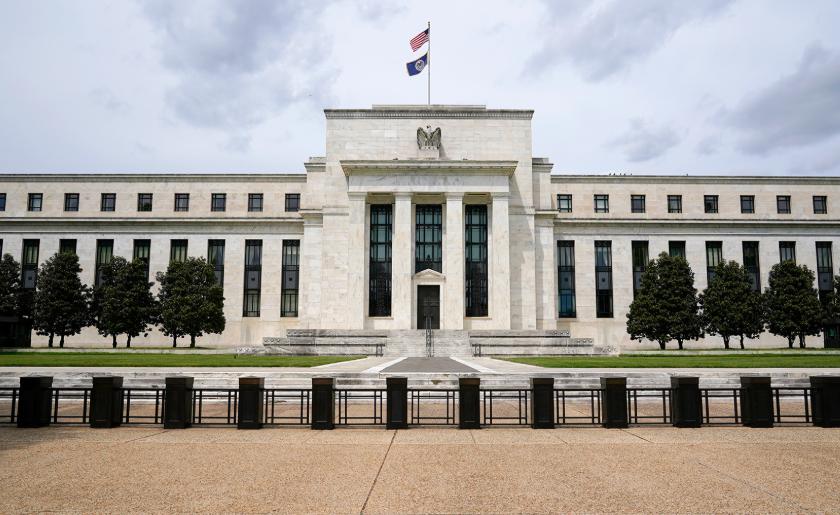
On October 22nd local time, the three major US stock indices closed lower. The latest data released by the US Treasury Department showed that as of October 21st, the total debt scale of the US federal government exceeded 38 trillion US dollars for the first time. It is reported that this was only two months after the US federal government's debt scale reached 37 trillion US dollars in mid-August. The Federal Reserve has presented a draft outline of an amendment to other US regulatory agencies, which will significantly relax the capital requirements for the largest banks during the Biden administration. Sources said that the White House is considering targeted regulations on export products using US software, which has further depressed the US stock market. However, this plan is not the only consideration and may not be implemented.
The first breakthrough of the total amount of US Treasury bonds has a profound impact on the global financial market. Firstly, it affects sovereign credit risk and the difficulty of financing. International credit rating agencies Fitch, Standard & Poor's, and Moody's have removed the US sovereign credit rating from AAA, reflecting market concerns about the sustainability of the US finances. At the same time, the debt-to-GDP ratio has been continuously increasing. From 2019 to 2024 fiscal years, the total US federal debt increased from 22.7 trillion US dollars to 38 trillion US dollars, an increase of 56.4%; while the nominal GDP only increased from 21.4 trillion US dollars to 25.7 trillion US dollars, an increase of approximately 20%. This imbalance directly led to the debt/GDP ratio exceeding 123%, far exceeding the 60% safety line set by the Maastricht Treaty. In a high-interest rate environment, the interest expense on US Treasury bonds is expected to reach 1.2 trillion US dollars in 2025, surpassing military spending to become the second-largest expenditure of the federal government. In the long term, debt interest may squeeze investment in key areas such as education, research, and infrastructure, weakening the country's long-term competitiveness. The proportion of traditional long-term investors has dropped to 6%, while the proportion of short-term speculative investors has risen to nearly 30%. This change has led to increased volatility in the liquidity of the Treasury market, with more intense price fluctuations in risk events.
Secondly, it has an impact on the global financial market. US Treasury bonds were once regarded as one of the safest assets in the world, but they have experienced "flash crashes" in risk events multiple times in recent years, with rising yields and falling prices coexisting, weakening their hedging function. The US Treasury bond yield is the benchmark interest rate in the global financial market, and its volatility increase may lead to chaos in the pricing of global bonds, stocks, and credit markets, increasing the difficulty of cross-market hedging. US Treasury bonds, as the core collateral in financial transactions, an increase in credit risk may force financial institutions to raise discount rates for collateral, exacerbating market liquidity tension. At the same time, the US debt crisis may trigger the depreciation of the US dollar, capital flight, and the depreciation of emerging market currencies and the rise of debt default risks. Oil and grain prices may soar due to market panic, exacerbating global inflation pressure. Moreover, if the US defaults on its debt, its impact will far exceed the 2008 financial crisis, triggering global asset selling, credit market freezing, and a sharp increase in unemployment rates.
Thirdly, it has an impact on the monetary system. The global process of de-dollarization is accelerating, with the settlement of some countries' currencies exceeding 90%. Emerging international currencies are used in 120 countries. The share of the US dollar in foreign exchange reserves has declined, and its importance may continue to weaken in the future. The combination of US trade policies (such as "reciprocal tariffs") and the debt crisis may push global trade settlements towards diversification, reducing reliance on the US dollar. The decline in the attractiveness of US Treasury bonds may lead international capital to flow to other assets (such as gold, non-US stock markets), but in the short term, it may still maintain a certain attractiveness due to the liquidity advantage of US assets.
In summary, the total amount of US government debt has exceeded 38 trillion US dollars, indicating that the fiscal sustainability of the United States is approaching the critical point. This round of debt expansion is no longer merely an economic issue; it is a deep crisis related to the restructuring of the international monetary system and the evolution of the global economic governance pattern. Its impact may last for several decades.

A large number of buildings in the Gaza Strip were destroyed by the war.
A large number of buildings in the Gaza Strip were destroye…
The US Senate has passed a compromise version of the Nation…
The European Commission released a package of measures for …
Venezuela's Vice President and Oil Minister Rodriguez said …
On December 16 local time, the Ministry of Space Science Ex…
Recently, a highly anticipated phone call between the defen…